by Gerald Horne
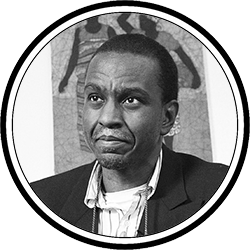
http://drapeau-rouge.tumblr.com/post/139428792849/rethinking-the-lumpen-gangsters-and-the-political
In his classic Eighteenth Brumaire of Louis Bonaparte, Karl Marx provides a vivid description of what he calls the lumpen proletariat: “vagabonds, discharged soldiers, discharged jailbirds, escaped galley slaves, swindlers, mountebanks, lazzaroni, pickpockets, tricksters, gamblers, maquereaus [procurers], brothel keepers, porters, literati, organ-grinders, knife grinders, tinkers, beggars” (1979, 149; see also Engels 1975 and Winston 1973, 75).
In his classic Eighteenth Brumaire of Louis Bonaparte, Karl Marx provides a vivid description of what he calls the lumpen proletariat: “vagabonds, discharged soldiers, discharged jailbirds, escaped galley slaves, swindlers, mountebanks, lazzaroni, pickpockets, tricksters, gamblers, maquereaus [procurers], brothel keepers, porters, literati, organ-grinders, knife grinders, tinkers, beggars” (1979, 149; see also Engels 1975 and Winston 1973, 75).
This class - or stratum - is not to be confused with the unemployed, or with the proletariat itself; indeed, this grouping tends to prey on the working class. They are the detritus of capitalism and, in some ways, form a mirror image of the parasitical and exploitative practices of the bourgeoisie itself.
Class analysis is a staple of the Marxist method, and volumes have been devoted to various classes, ranging from the bourgeoisie to the petit bourgeoisie to the working class to the peasantry. Herbert Aptheker’s work on slavery can also be seen in this context in that it focuses on the irreconcilable antagonism between one class, slaves, and another class, slaveholders.
The lumpen proletariat, however, has not received the kind of sustained attention it deserves in the analysis of capitalism. This is unfortunate, for the lumpen over time have come to play an increasingly outsized role in the evolution of exploitative societies. Indeed, as one examines the fate of the former Soviet Union, it is apparent that what has transpired over the past decade is the decline of working-class organization and ideology and the rise of the lumpen (Sterling 1994; Handelman 1995).
In the United States, the lumpen historically have played a large role. Just as England dumped lumpen elements in its colony of Australia, it did the same thing in Georgia and other colonies (Salgado 1982; Hughes 1987; Wood 1984; Galenson 1991; Asbury 1928). This served multiple purposes: it provided a safety valve for England itself, allowing the nation to rid itself of elements that might be disruptive and that were viewed as undesirable. Moreover, the kind of violence and subterfuge necessary to subdue indigenous peoples, whether they were in Australia or North America, was a particular specialty of “mountebanks,… tricksters,… brothel keepers” and the like, acting at the behest of powerful elites.
What needs to be considered more carefully is that over time not only did lumpen elements, particularly in the United States, develop powerful syndicates or organized crime families but some lumpen elements also, like a caterpillar becoming a butterfly, became part of the bourgeoisie itself and came to influence the already degraded culture of the bourgeoisie. Indeed, scholars and activists need to pay more attention to the role that organized crime has played in the evolution of the vaunted U.S. economy (Johnson 1995a; Browning and Gerassi 1980). Seeing imperialism itself as a form of organized crime tells us quite a bit, but not enough.
In the United States, the lumpen have come to dominate entire sectors of the economy and have attained particular influence within an industry that garners enormous profits while shaping consciousness - the entertainment industry. The images flowing from this industry have blanketed the planet and helped to inject the culture of U.S. imperialism into the four corners of the globe. Again, the import of this development needs to be considered more carefully, if we are ever to understand and subvert imperialism itself.
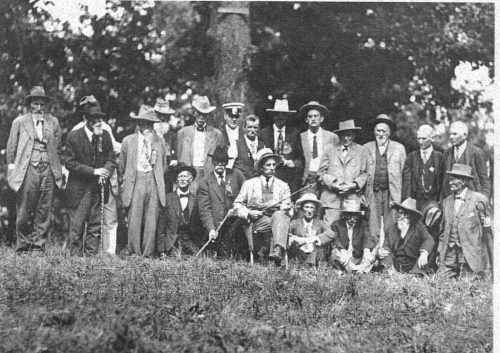
[Quantrill’s Raiders, pro-slavery organization aligned with Confederacy during American Civil War]
Of all of the crimes perpetrated by colonialism and imperialism in Africa, one of the most dastardly has been the dumping of lumpen elements in colonized lands. In 1961, the Bureau of African Affairs in Kwame Nkrumah’s Ghana, quoting Sir Cornwall Lewis, sadly reflected on the social costs of this practice: “The scum of England is poured into the colonies, briefless barristers, broken-down merchants, ruined debauchees, the offal of every calling and profession are crammed into colonial places.” Citing the author Mabel Jackson, the report continued, “Each year a shipload of human flotsam and jetsam is sent to Angola and Mozambique from Portugal. Beggars embittered by hardship, thieves, assassins, incorrigible soldiers and sailors, together with a sprinkling of political exiles are dumped into the colonies. She tells us that sometimes these men are called degradados - [and] are accompanied by their wives who are girls from orphanages or reformatory schools whom they marry at the moment of embarkation from Europe” (Voice of Africa 1961).
These declassed elements took quite quickly to the reigning philosophy of white supremacy, as this new racial status of “whiteness” rescued them from their declining class status (see, for example, Roediger 1991, Ignatiev 1995, and Saxton 1991). Over time they helped to introduce and fortify a lumpen culture that is bedeviling independent Africa to this day.
Lumpen elements also have played a key role in another phenomenon that has plagued Africa over the years: mercenaries. Of course, the deployment of European mercenaries was not unique to Africa. For years the Swiss developed a notorious reputation as suppliers of mercenary forces to various regimes in Europe; these regiments were heavily lumpen (McCormack 1993, 80; see also Langley and Schoonover 1995). The promiscuous use of mercenaries was a close cousin to the deployment of pirates, buccaneers, and soldiers of fortune, whose bloodthirsty escapades often were the basis of the primitive accumulation of capital itself. One scholar has observed that the concept of “plausible deniability,” which has served imperialism so well in episodes ranging from Watergate to the Iran-Contra scandal, was actually invented by rulers in the early seventeenth century as a spur to mercenarism and piracy: thus, if these bandits obtained the necessary booty - fine - and if they did not or were apprehended, then responsibility for their activity could be denied (Thomson 1994; Tilly 1990).
These freebooters were a useful adjunct to U.S. foreign policy, as this young nation in the nineteenth century sought to seize territory throughout the hemisphere and beyond and to circumvent the ban on the slave trade (Brown 1980; Smith 1978; Krasner 1978). When the Civil War began, many of these forces joined with the Confederacy and terrorized entire states, particularly Kansas. A noteworthy band of thugs, Quantrill’s Raiders, spawned the notorious outlaws Jesse and Frank James, Cole Younger, and a generation of cutthroats, providing a vivid example of the connections between the lumpen, racism, and war (Schultz 1996).
Nevertheless, the impact of what the Portuguese call the degradados has been most dramatic in the continent that Western Europe has specialized in degrading - Africa. The dumping of these forces in Africa continues to resonate, even though European colonialism has been uprooted. For example, in South Africa, the apartheid authorities concentrated more on fighting political dissent than crime. As a result, independent South Africa is faced with a staggering crime problem, fueled by what one newspaper there has called “state sponsored gangs who used government patronage to build criminal business empires.” In the province of Mpumulanga they are called “businessmen’s gangs” and were known to have worked with the Zulu chauvinist Inkatha Freedom Party; one gang was “run by five heavyweight black businessmen” (Weekly Mail and Guardian, 6–12 September 1996). An estimated 278 organized crime syndicates in South Africa are involved in drug-dealing, car-jacking, and worse (Zimbabwe Herald, 15 February 1996). Then there are the firms of mercenaries, such as Executive Outcomes, that sell their services to governments in exchange for diamond concessions (Horne 1995a).
Of course, the lumpen are far from being unique to Africa. In Japan, the highly influential Yakuza - gangsters known for their tattooed bodies and amputated fingers - are quite close to certain financial elites. They pioneered in running movie houses, strip shows, prostitution, and gambling (Saga 1991, 195). In China, before the advent of Communist Party rule, the nationalist forces under Chiang Kai-shek collaborated with racketeers like Du Yuesheng of the notorious Green Gang; these thugs acted as labor bosses and plant managers and helped the nationalists break workers’ power in 1927 (Wakeman 1994; see also Emsley and Knafla 1996).
Even today, according to the Far Eastern Economic Review (1 May 1997), it is estimated conservatively that about 10 percent of the elected officials in the legislature and National Assembly of Taiwan had gang affiliations. Taiwan’s most well known gang-affiliated politician, Luo Fu-tsu, “has identified himself as the ‘spiritual leader’ of one of Taiwan’s largest gangs, the Heavenly Way Alliance.” He is also “chairman of the legislature’s judiciary committee,” which formulates the basic laws of this rebel province of China.
Ascertaining the influence of this pervasive lumpen culture on the political culture of China - including the culture of the Communist Party - is a task worthy of consideration. In any event, these racketeers flourish during times of unrest and war, when normal channels of production are disrupted, as was the case, for example, in London during World War II (Murphy 1993, 81).
It is clear that the lumpen have not always had an entirely baneful impact. The role of “social bandits” is well known (Perez 1989; Schwartz 1989). Just as one distinguishes between big and small peasants and between workers who make $1 million a year and those who earn less than $10,000, one must make distinctions among various types of lumpen in their sociopolitical impact and potential. Still, as Alisse Waterston has pointed out, what must be carefully scrutinized is the rampant notion that gangsters represent some sort of culture of resistance to capitalism. There may be a scintilla of evidence imbedded in this idea but often ignored is the salient point that gangsters in the United States most notably have been highly accommodating to larger cultural norms and to the requisites of social production. Ultimately their defiance is limited to symbolic suggestion and often remains on the level of appearance. Indeed, the experience of most gangsters in this nation suggests that their goals are congruent with and help to sustain the goals of capitalism itself. The heralding of the alleged resistance represented by gangsters obscures their true role in social reproduction, subverts actual resistance, and helps to suppress alternatives - particularly those of the working-class variety (Waterston 1994).
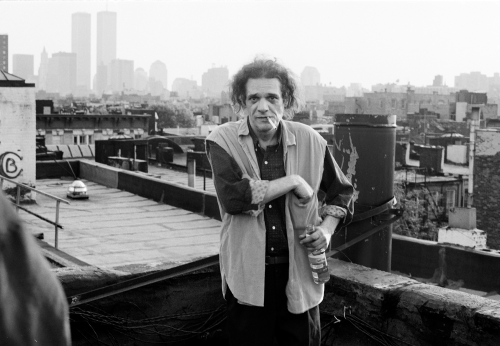
[Herbert Hunke]
In the United States, organized crime is reported to have significant influence in the construction industry, the vending machine industry, waste removal, and the usual staples of gambling, drugs, prostitution, and the like. Gangsters also have influence in areas where their presence has not attracted attention. For example, much attention is devoted to the pornography industry, particularly the issue of whether it is misogynist and should be restrained or, as some would have it, not to be tampered with because it is the truest expression of free speech (Kipnis 1996; Hunt 1991; Dworkin 1989). What is rarely mentioned - though highly relevant - is that this is one of many industries where racketeers wield hegemony; similarly, at least before the 1960s, the same could be said about so-called “adult bookstores” and gay clubs (Potter 1986; Washington Post, 12 April 1979).
The failure to divine the role of organized crime makes it difficult to analyze complex phenomena fully. For example, the music industry is one of the few industries where African Americans have played a central role. Here they have encountered the pervasive role of mobsters, some of whom were Jewish and Italian-Americans. Because of a failure to examine a particularly vile form of class exploitation, this antagonism has often been expressed in racial and ethnoreligious terms.
Thus, legendary music critic and producer John Hammond estimated that at one time “no fewer than three in every four jazz clubs and cabarets… were either fronted, backed, or in some way managed by Jewish and Sicilian mobsters” (Morris 1980, 4). Morris Levy, who owned the famous club Birdland, “never made any secret of his connections with the New York Mafia… Many have speculated that it was the Mob who put Levy in business and that he is beholden to gangsters to this day” (Picardie and Wade 1990, 53, 57). Crass exploitation of musicians - particularly African-American musicians - is widespread. Sadly, when objection was made to those of Levy’s ilk, more attention was at times paid to his ethnoreligious, rather than class, background.
Unfortunately, U.S. popular culture - and not just “gangsta rap” - is suffused with the influence of lumpen elements, which is one reason why it has been so stiffly resisted worldwide. This has not only been true of music and, as will be shown shortly, film, but literature as well. Herbert Huncke, described by the New York Times (9 August 1996) as a prostitute, “street hustler, petty thief and perennial drug addict,” was better known as the man “who enthralled and inspired a galaxy of acclaimed writers and gave the Beat Generation its name”; he was a former “runner for the Capone” gang and spent eleven years in prison, “including almost all of the 1950s.” He was featured in works by writers ranging from William Burroughs (1966) to Allan Ginsberg (1956) to Jack Kerouac (1957). This beat generation played a major role in shaping a U.S. youth culture of the 1960s that has had global influence.
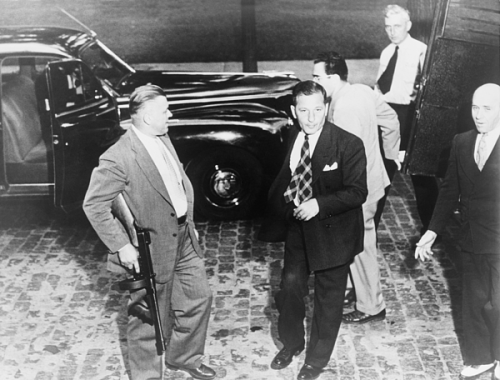
[Louis “Lepke” Buchalter, mafia racketeer and head of Murder Inc.]
What is most revealing about the role of gangsters in the political economy is their historic function as a disruptive force within the trade-union movement. Here their role as accomplice of the bourgeoisie and parasite is exposed crudely. In his analysis of the Fur and Leather Workers Union, Philip S. Foner limned “the vast chain that connected anti-labor employers, right-wing Socialist union chiefs and the most notorious of all gangs of underworld criminals,” referring to Louis (Lepke) Buchalter and Jacob (Gurrah) Shapiro (1950, 396). Sidney Lens reported that “Lepke and Gurrah at one time had two hundred and fifty thugs on their payroll to help run the New York painter’s union” (1949, 68). Congressional hearings during the 1930s investigated what Leo Huberman termed the “labor spy racket,” an entire industry that did the dirty work of disrupting unions on behalf of corporate elites (Huberman 1937; Howard 1924).
In his analysis of Ford Motor Company’s use of mobsters, Stephen Norwood has observed that the United States is “the only advanced industrial country where business corporations wielded coercive military power.” Harry Bennett, Henry Ford’s top aide, was close to “Detroit’s underworld,” which was pivotal in the “violence and espionage” that animated “management’s campaign to disrupt union organizing and break strikes” (1996, 367, 391). Indeed, in comprehending the weakness of the Left and the ascendancy of the Right in the United States, progressive forces have paid insufficient attention to the totality of the opposition faced by the working class.
The Teamsters, for decades one of the largest unions in the capitalist world, has been known as a union where mobsters held great influence. Union officials who opposed their rule were killed, and business at times was complicit in this effort (Witwer 1994, 175, 233). In Las Vegas, where mob-dominated unions have been prevalent, financiers like George Wingfield - a patron of the Republican Party - employed unsavory characters to keep unions out of the state and keep quiescent those who were not chased away (Raymond 1993, 79).
Organized crime - the “big lumpen” - historically has been one of the bourgeoisie’s chief allies in this nation in maintaining its hegemony. In return, gangsters have been allowed, in some instances, to evolve “respectably” to bourgeois status themselves. In any case, mobsters in this nation have enjoyed a form of enrichment that the bourgeoisie in many nations will never see. This has added a level of coarseness and lack of principle to the otherwise crude and unprincipled rule of the bourgeoisie.
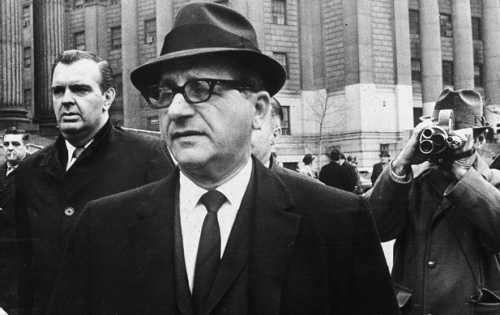
[Sam Giancana, American mobster who conspired with the CIA to assassinate Fidel Castro]
An examination of the memoirs and biographies of top U.S. mobsters is quite instructive in revealing their close ties with the state and the bourgeoisie, their ethnocentrism, and their ties to the entertainment industry. Arnold Rothstein, for example, has been given credit for bribing members of the Chicago White Sox to lose intentionally in the 1919 “World Series” of baseball. In his hometown of New York City there was an “alliance between [the] political machine [Tammany] and crime”; moreover, “much of Rothstein’s bankroll came from Wall Street.” In fact, Rothstein was one of the earliest investors in “Loew’s Inc., parent company of MGM,” the film company. Rothstein acted as “middle man in the deal whereby [Horace] Stoneham, John McGraw and Judge McQuade purchased the New York Giants baseball team” (Katcher 1994, 73, 165, 192).
Meyer Lansky, a top mobster for decades, had business relationships with the Bronfman family, who started Seagram’s, and with Lewis Rosensteil of Schenley’s, who was close to FBI head J. Edgar Hoover. Lansky discussed international politics constantly and sensed earlier than most the triumph of the Cuban revolution, an event that led to substantial business losses for him and other mobsters; this event helped to spur an alliance between mobsters and the U.S. government to oust the Castro regime. Early on, Lansky contributed heavily to Zionist causes and later in life, because of perceived anti-Semitism on the part of his Italian-American colleagues - and in a transparent attempt to escape the long arm of the law - went to live in Israel; his effort to avoid deportation was backed by the Ultraright there. Lansky invested heavily in Las Vegas and felt that “the WASPS couldn’t have it… that a bunch of Jewish and Italian street boys could make so much money in Vegas and other places. They wanted to drive us out and finally they succeeded” (Lacey 1991, 55, 80, 255, 291, 337).
Sam Giancana, who shared a mistress with John F. Kennedy, bragged that organized crime sponsored stars, including “the Marx brothers, George Raft, Jimmy Durante, Marie McDonald, Clark Gable, Gary Cooper, Jean Harlow, Cary Grant and Wendy Barrie.” He said that then President Harry Truman was “their boy” and added that the mob in “Chicago used its money and influence to try and get close to everybody from Ronald Reagan to Ed Sullivan.” Mobster Diamond Joe Esposito “routinely boasted of meeting with Calvin Coolidge and dispensing votes and favors at the President’s request.” Giancana “often conducted business with producer Harry Cohn” of Hollywood and proved helpful to him in his conflicts with unions. Indeed, the mob wanted a “takeover of unions, coast to coast… . By threatening union members with loss of work, the gangsters could marshal the efforts of husbands, wives, sons, and daughters in support of virtually any scam the gang could dream up, including swinging an election” (Giancana 1992, 34, 105, 107, 158, 409).
Mickey Cohen, the top mobster in Los Angeles during the 1940s and 1950s, raised large sums for the Irgun in Israel. He was not alone in exploiting consciousness; Jack Dragna, another top mobster in Los Angeles, also was the head of a leading Italian-American civil rights organization in the city of stars. Like Lansky, Cohen was quite sensitive to real and imagined anti-Semitism at the hands of his Italian-American colleagues and others. Cohen also was close to studio boss Harry Cohn, but refused his request to murder Sammy Davis Jr. after the AfricanAmerican star created a controversy because of his intimate relationship with actress Kim Novak. Like many other top mobsters, Cohen was close to Frank Sinatra, who once aligned with the Left but later became a top supporter of the Republican Party. Cohen too had political connections, claiming that “at one point during the 1940s and 1950s I had the police commission in Los Angeles going for me. A lot of the commissioners didn’t have any choice. Either they would go along with the program, or they would be pushed out of sight.” He funneled money to the political campaigns of Mayor Fletcher Bowron and added, “I had the private number in his office and the private number in his home.” He also raised funds for the early political campaigns of Richard M. Nixon. He was grateful to the press controlled by William Randolph Hearst, which portrayed him as “sort of like a Robin Hood” and ordered his press organs to refer to the mobster as a “gambler” not a “hoodlum” (Cohen 1975, 43, 83 91, 95, 106, 232; see also Reid 1973, 110, 171).
Abner “Longy” Zillman, a top hoodlum from New Jersey, also felt that “most of the Italian gangsters in New York were anti-Semites”; he too was close to Harry Cohn of Columbia Pictures and the Schenck Brothers of MGM, not to mention Dore Schary, “a boyhood friend” and yet another key movie executive. He too took a decided interest in unions though “this stemmed… from a need to find jobs for his army of relatives.” Like Cohen and Lanksy, he had widespread interests, including steel mills, Kinney Parking Systems (eventually absorbed by Time-Warner), jukeboxes, hotels, clubs, etc. (Stuart 1985, 50, 188, 88–89, 97).
An examination of the lives of mobsters raises intriguing questions worthy of investigation, even if one does not accept every aspect of their stories. If one examines “ethnic cleansing” in the Balkans, for example, it is apparent that organized crime figures like Arkan, who happen to be ultranationalists, basically plunder and loot other nationalities and hand over the booty to their “blood brothers” who join them; lumpen activity makes use of ethnicity for its own purposes (Rieff 1995; CNN 1997). Organized crime “families” have operated on a similar principle, insofar as they have tended toward ethnocentrism and have spread their plunder among members of the “family.” This raises the question of the extent to which the resurgence of nationalism nowadays has a distinctly lumpen flavor. As noted, the construction of “white” identity in colonized Africa was based predominantly on a shared melanin deficiency and the sharing of booty looted from the Africans.
Then there is the mobsters’ distinct view of “sex.” Homosexual rape has been a staple of punishment preferred by gangsters and, unfortunately, has become part of the culture of some prisons where they enjoy hegemony. Like its heterosexual counterpart, homosexual rape is more a crime of violence and subordination than a sexual act. Thus, a favored tactic of punishment by Giancana was shoving a poker “right up [the] ass of opponents”; Giancana once threatened to put a gun “up [the] ass” of an opponent and pull the trigger. When William Jackson was murdered by the mob, they “rammed an electric prod up his rectum” (Giancana 1992, 100, 148, 397).
The mob in pre-1959 Cuba specialized in holding sex shows, featuring live sex acts, particularly “lesbian acts” (Ragano and Raab, 1994, 46). Cohen bragged about owning “gay places,” though he quickly added, “I never had to go into them” (1975, 223). It is recorded that pirates, the precursors of organized crime, at times tended toward similar views of sexuality (Burg 1982). What needs to be interrogated more systematically is the influence of the lumpen - beyond male and female prostitution - on the sexual culture of the United States, particularly the linkages between sex and violence (Chauncy 1994; Faderman 1991; Duberman 1991).
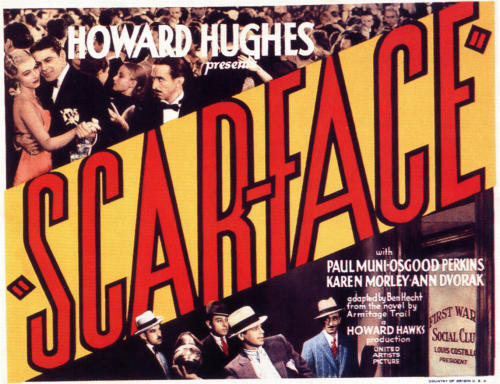
Such interrogations are necessary, for it is apparent that progressive forces may have underestimated the pervasive influence of organized crime on U.S. culture, despite its obvious role in assassination plots here and abroad. This is a shame, for as the United States spreads its tentacles of influence to Russia, the Balkans, and other parts of the globe, there has been an inevitable and not coincidental rise in organized crime. The influence of the mob has been hidden in plain view - its very prominence in the headlines and on the silver screen has dulled our sensitivity to its impact. New York Times investigative journalist Jeff Gerth is not far from the mark when he suggests that
organized crime has quietly entrenched itself within all levels of the social structure, leading Donald Cressey, consultant to the President’s Commission on Violence, to conclude: “The penetration of business and government by organized crime has been so complete that it is no longer possible to differentiate ‘underworld’ gangsters from ‘upperworld’ businessmen and government officials.” (1976, 132).
These connections have been particularly evident in California and most notable in the careers of two of this state’s favorite sons, Richard Nixon and Ronald Reagan. California, the “last frontier,” within the past century was involved in an event that called for the bloodthirsty tactics that the lumpen have specialized in - the expropriation of the Native Americans. Here on the frontier, as Mickey Cohen has detailed, mobsters openly consorted with elected officials and otherwise “respectable” business figures. To cite one instance: Guy McAfee, chief of the vice squad of the Los Angeles Police Department in the 1930s, built a career in bookmaking and casino operations in league with mob figures; he helped build the Golden Nugget in Las Vegas, for example (Johnson 1975b, 55).
What is fascinating is that few of these relationships were shrouded in secrecy. Michael Denning has noted that “the pulp magazines were full of gangster stories; by the early 1930s, there were entire magazines devoted to ‘Gangster Stories,’ ‘Racketeer Stories,’ and ‘Gangland Detective Stories’” (1997, 254). Strikingly, the narrative that focused on the expropriation of the land of the Native Americans - the “western” - was supplanted in Hollywood by the gangster movie, which simply updated the story of plunder and politics (Dargis 1996).
Those who played gangsters on the silver screen, like George Raft, were close to real-life gangsters like Bugsy Siegel and Owney Madden. Howard Hughes, the industrialist, was a partner with Siegel in the Flamingo of Las Vegas. The director Howard Hawks was buddy-buddy with Al Capone. The movie Scarface included scenes from gangster life, such as Raft and Paul Muni bringing flowers to a rival gangster in a hospital, then pulling a gun out of the flowers and shooting him (Munn 1993, 32, 89, 204). Indeed, Meyer Lansky suggests, real mobsters learned from Raft styles of dress and mannerisms that came to define the gangster mode (Lacey 1991, 148).
Los Angeles and its primary industry, Hollywood, became an enormous source of profit for gangsters and, in turn, a massive recruiting broadside and image polisher for the gangster life. F. Scott Fitzgerald hinted at this dark alliance in his novel about Hollywood, The Last Tycoon (1969). This alliance deepened during the Depression of the 1930s when, according to one analyst, the studios were strapped for cash and mobsters like Longy Zwillman, who had preexisting relationships with Hollywood executives, provided an infusion of capital. This analyst, Hank Messick, has charged further that as a result of this alliance and “under the pressure of gangsters, art was being abandoned in favor of fast-buck productions designed to appeal to the largest common denominator of society” (1973, ix, 51–52).
Still, the major import of this alliance was not solely relevant to the state of cinema art. No, this alliance aided mobsters in spreading their influence among unions, particularly unions in Hollywood - Teamsters, painters, and the like - and increased their influence in society at large. Again, this relationship was no secret. Early on, Orson Welles sensed the deeper implications of this when he observed,
A group of industrialists finance a group of gangsters to break trade unionism, to check the threat of socialism, the menace of socialism or the possibility of democracy… When the gangsters succeed at what they were paid to do, they turn on the men who paid them… The puppet masters find their creatures taking on a terrible life of their own. (Denning 1997, 375)
Whether one accepts the analysis of Messick or Welles, the point is that there was a clear and open relationship between mobsters and one of the most profitable industries in the nation.
Thus the Washington Times-Herald complained on 26 September 1947 that most of the “California gangsters… either have social entree among the parvenus or themselves rank as the Astors and Vanderbilts of their time and place.” It was not accidental that this comment was made during a year when the postwar upsurge of strikes presented a direct and perceived threat to the hegemony of the bourgeoisie, which looked to the muscle of the mob to crush this insurgency. At the same time the infamous Merchants and Manufacturers Association of Los Angeles formed a Citizens Law and Order Committee to back up the Los Angeles Police Department in confronting strikers (Labor Herald, 15 February 1946).
Hollywood itself was being confronted with militant strikers in the wake of the dislodging of mob-dominated union leadership of the International Alliance of Theatrical Stage Employees (IATSE) and the rise of a militant Left-led Conference of Studio Unions.
The story actually begins in the 1930s when the studios became heavily dependent on mob money. At this juncture, Al Capone managed to install two of his cronies, Willie Bioff and George Browne, as leaders of the key film union, IATSE. The two quickly became comfortable with the allures of Southern California. Bioff, a convicted pimp who boasted of drinking one hundred bottles of beer in one sitting, came to own stock in Fox and became friendly with Harry Warner. He owned eighty lush acres in the San Fernando Valley “hard by the estates of Tyrone Power and Annabella, Clark Gable and Carole Lombard”; his estate included “$600 olive trees,… the biggest and oldest in California” (Muir 1940, 11; Chicago Daily News, 19 July 1935; Chicago Tribune, 12 June 1935).
As World War II approached, however, the enthusiasm for the mobsters, many of whom were sympathetic to Mussolini, began to crumble. The studios admittedly had been paying Bioff and Browne handsomely to maintain labor peace; however, an indictment of the labor leaders charged that this was not bribery but extortion. Capone’s chief lieutenant, Frank Nitti, committed suicide after his indictment - at least he was found with a bullet in his skull (New York Times, 20 March 1943; 5 November 1943; 28 October 1941).
Bioff and Browne wound up turning on their mob partners and testifying against them. Among those convicted as a result was Johnny Roselli, the mob’s key operative in Southern California. Born Filippo Sacco in Esteria, Italy, in 1905, he came to the United States in 191l and quickly became involved in criminal activity. He rose to a position of authority among mobsters, became the “mafia’s bridge” to Mayor Frank Shaw of Los Angeles, and was the chief “labor enforcer” for the film industry. As his biographers put it,
The sudden and enormous success of the movies spawned an orgy of vice that threatened to shatter the industry. Drug use was widespread, including cocaine, heroin and illegal alcohol. Sexual favors were demanded by casting directors and became a sort of alternative currency. Mack Sennett’s Keystone Studios had to be tented and fumigated of venereal crabs.
Gambling was rife and controlled by the mob, with studio executives dropping as much as $15,000 in one evening. Roselli was “instrumental” in the success of Harry Cohn and Columbia Studios; they lived in the same apartment building and exchanged rings. The “closest friend” of MGM’s Louis B. Mayer was Roselli’s mob comrade, Frank Orsatti (Rappley and Becker 1991, 75, 54, 60, 62).
But all of his elevated connections did not prevent Roselli from being convicted and sentenced in 1944. In 1945 the Conference of Studio Unions (CSU) led a bitter and acrimonious eight-month strike. When the studio retaliated by locking them out in 1946, picket lines were once more punctuated with regular scenes of violence. In 1947 Roselli was surprisingly released from prison, with some suggesting that his studio friends required the muscle he could muster in order to squash the CSU once and for all. His parole caused a “national scandal”; his attorney, Paul Dillon, had served as Harry S. Truman’s senatorial campaign manager, and these connections were seen as important in gaining his premature release (Johnson 1950, 30; Los Angeles Times, 5 July 1987)
The CSU was squashed, and Roselli reentered the film industry, this time as a producer. Among his works were T-Men, Canon City, and He Walked by Night. These films were “popular with critics and fans, and became a major influence on early radio and television shows such as Dragnet.” He also became involved in business dealings with the Guatemalan military in the early 1950s, reputedly participating in the overthrow of Jacobo Arbenz in 1954, and he developed close ties to the Teamsters, Joseph Kennedy, and Las Vegas casinos. He was recruited by the Central Intelligence Agency to murder Fidel Castro. In the mid-1970s his torso was found in an oil drum floating off Miami Bay as a congressional committee called him as a witness in an investigation of his more nefarious activities. Bioff changed his name and moved to Phoenix, where he became friendly with Senator Barry Goldwater; his luck ran out in the midfifties when he was killed by a car bomb (Rappley 1991, 155, 202; Clarens 1980, 167; Los Angeles Times, 28 July 1948; Los Angeles Examiner, 26 August 1948).
Meanwhile, as they were going down to defeat, the CSU proclaimed that the “gangsters are coming…. The pay-off boys, slot machine kings, brothel keepers and underworld characters kicked out of town when the people recalled Mayor Frank Shaw” are back; “the movie magnates have allied themselves in the underworld … as they did in the days of Shaw” (CSU ca. 1945/1946).
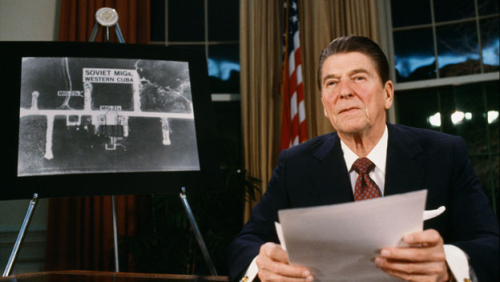
[Snitch Ronald Reagan]
The odyssey of Johnny Roselli was not the only intriguing aspect of the aftermath of the crushing of the CSU. Ronald Reagan, the former liberal leader of the Screen Actors Guild, aligned with the studios during this labor unrest; as a result he developed relationships with corporate leaders that were to prove essential in his subsequent races for elective office.
Sidney Korshak, a lawyer during Roselli’s trial who had once served as counsel to Capone, went on to become, in the words of one FBI official, the “primary link between big business and organized crime.” Lew Wasserman, formerly Reagan’s agent, called Korshak “a very good personal friend.” Korshak also had Hilton Hotels, MGM Hotel, Paramount, and General Dynamics as clients; he was friendly with J. Edgar Hoover. Wasserman had reason to be grateful to Reagan, since Reagan (when head of the Screen Actors Guild) allowed Wasserman to serve as both agent for actors and as their employer (Wasserman was head of MCAUniversal studio). This circumvented antitrust guidelines. Wasserman also was a major donor to the Democratic Party. Korshak was also quite close to the producer of the Godfather saga, Robert Evans, illustrating once again the close link between screen representations and reality (New York Times, 22 January 1996; Hollywood Reporter, 19 August 1994; Moldea 1986; U.S. Congress 1951).
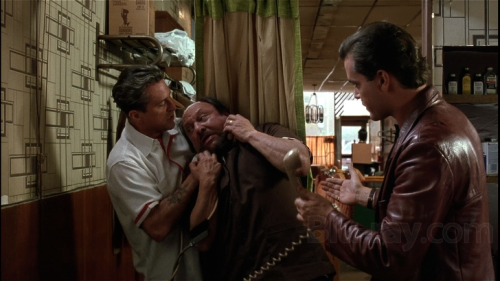
[Goodfellas (1990]
The crushing of the Conference of Studio Unions after World War II was an essential element in cementing the ongoing trend of the increasingly pervasive influence on unions of organized crime - in other words, the ascendancy of lumpen organization and the decline of working-class organization in the United States. Despite the change in leadership in the AFL-CIO in October 1995 and subsequent reforms in the associated unions, including the Teamsters, this tendency persists (New York Times, 24 January 1992, 22 June 1990, 9 April 1989, 21 February 1984, 28 April 1983, 12 December 1980, 9 February 1980; Los Angeles Times, 9 February 1984;Business Week, 14 February 1983; Wall Street Journal, 5 October 1982; U.S. News and World Report, 8 September 1980; National Law Journal, 29 February 1988). For example, Teamsters Local 817 in New York City, which represents many theater workers, is heavily influenced by the gang known as the Westies (English 1990, 155).
The movies and television, with their glamorizing of Goodfellas and The Last Don and The Krays, and the “Teflon Don” and “Sammy the Bull,” continue to play a substantial role in sanitizing their partners, the mobsters. Of late, this trend has afflicted newspapers as well; the New York Times recently lauded pirates as true democrats - sure, they looted treasures from Africa and kidnapped Africans for slavery but, after all, they shared the booty among themselves (11 March 1997).
The projecting of glamorous images of gun-toting thugs has not only been instrumental in providing legitimacy to them at home, it has also served to spread lumpen organization and culture abroad, lubricating the path for U.S. imperialism by undermining domestic working-class oppositional culture. Jamaican gangsters, for example, “worshipped the gunfighters in Hollywood westerns”; in Kingston there was a “time honored tradition of gunmen modeling themselves on Hollywood desperadoes.” There was a “secret symbiosis” between these Caribbean gunfighters cum “mercenaries” and “politicians”; this worked to the detriment of the working-class opposition led in the 1980s by the social democratic leader Michael Manley (Gunst 1995, xiv, 9, 74, 81).
As the example of Jamaica suggests, it did not escape the attention of many Blacks that others had amassed enormous wealth and improved their status as a group under capitalism by taking the route of the lumpen. Blacks in the United States perhaps most notably in South Los Angeles - have not been blind to developments in the neighboring area of Hollywood. This led to the creation of “gangsta rap” and music moguls with plans as audacious as their lumpen brethren of the 1930s; yet somehow, in typical U.S. fashion, the discourse on this latter-day phenomenon has avoided making this obvious connection.
As early as the 1970s, African Americans had organized the Fairplay Committee - comprised of “an intimidating group of people” to improve their status in the music industry. They were trying to form a “black ‘family’ who would oppose the ‘families’” that controlled the business. In response, music impresario Morris Levy hired an African-American, Nat McCalla, “one of the first blacks ever to be admitted to the ranks of the Italian Mafia.” But this entente did not calm racial tensions; one mobster was irate about the rise of Black-owned Stax Records: “We just took over their publishing company and we are going to take over the record company, put all those niggers out, and put that head nigger in jail.” All of these racist dreams were not realized; however, in 1980 McCalla was “shot in the back of the head” in Fort Lauderdale and this early attempt of Blacks to take the lumpen route in the music industry was derailed (Picardie 1990, 173, 177, 192–93; 253).
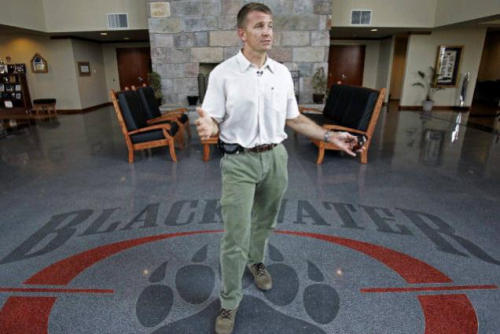
Years ago Max Weber defined the state as the agency which held a monopoly of legitimate violence in the area under its control. However, even in the days of Weber, this was rarely true in the absolute sense, as various lumpen - from mercenaries to pirates to mobsters - regularly used violence, particularly against enemies of elites, such as the unions. The ability of these lumpen to deploy violence is just another example of a traditional goal of right-wing elites - diminishing the role of the state and increasing the role of nonstate actors. One would think that creating two, three, or many Somalias, where the state was eviscerated and the ability to survive was often dependent on the protection to be received by families - organized crime or otherwise - is the ultimate goal of these elites.
The Economist, in the same story in which it cited Weber’s familiar aphorism, noted the proliferation of private police forces in recent days.
Since 1970 a transformation has been under way. In that year, there were still more public policemen than private guards in America. The ratio of public to private was 14:l. Now there are three times as many private policemen as public ones; in California, four times as many. General Motors alone had a private police force of 4200 more than all but five American cities. (19 April 1997)
In Northern Ireland “punishment squads” have arisen, “gangs who beat up their victims with baseball bats to suppress crimes in Loyalist or Catholic areas.” These squads have assumed the role that police departments have played (Johnson 1992; McKenzie 1994). Such developments are made to order for exploitation by organized crime factions, who are best able to fill the breach when the state withdraws (see, e.g., Horne 1995b). Such developments also provide unique career opportunities for those with a violent bent; Timothy McVeigh, convicted of blowing up the federal building in Oklahoma City in April 1995, is a former private security guard (Zielinski 1995, 50).
Meanwhile, the assault on the state and the decline of the Left, has opened rare and extraordinary opportunities for the lumpen. Often in conjunction with “legitimate” business, organized crime gangs have caused money laundering and drug dealing to expand exponentially (Chossudovsy 1996). It is almost as if the United States, which began as a nation with an enormous boost from England’s deported lumpen, now, two hundred years later, is not only still the land of opportunity for gangsters, but is exporting its model abroad and in the process is helping to create various “gangster republics.”
In any event, as we confront the new millennium, a few points are obvious: certainly an acceleration of working-class ideology and organization is a must, but a condition precedent to this development is a better understanding - and subverting of - the lumpen ideology and organization that have become staples of U.S. imperialism.

No comments:
Post a Comment